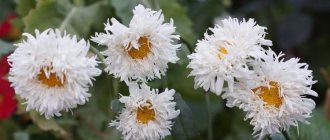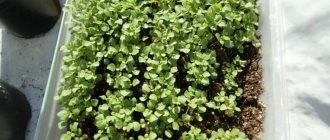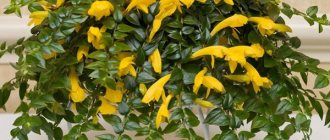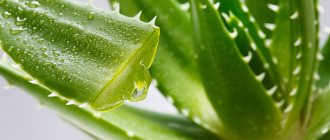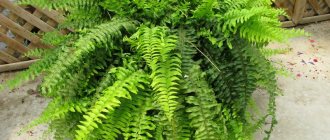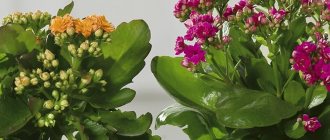The shrub plant Ledum cannot be called a native ornamental plant, since under natural conditions it prefers to grow in marshy areas. But now the culture has begun to be actively used for decorative and medicinal purposes. Despite the fact that the name of the plant is translated as “intoxicating”, “intoxicating” and “poisonous”, it is quite popular in our latitudes. In this article we suggest that you familiarize yourself with the plant, which is also called Bedbug, Bagula, Oregano and Hemlock, and the features of its cultivation.
Description of the plant
This shrub, which in adulthood can reach a height of up to one and a half meters, has a branched root system, a straight trunk, covered with regular oblong leaves. The branches are brown, pubescent. It grows in swamps and swampy forests and has many names: bedbug, bagoong, hemlock, sleepy stupor and others, which accurately characterize its aromatic properties.
The flowers of wild rosemary, white, sometimes pink, form an umbrella and are located at the end of the branches. The flowering period occurs in May and June, at this time it is quite dangerous for health to be near this shrub, as it emits a stupefying aroma that can cause headaches, even loss of consciousness. The plant is extremely poisonous, this applies not only to the flowers, but to the entire bush. There are several types of wild rosemary:
- Bolotny.
- Greenlandic.
- Large-leaved.
After flowering ends, fruits are formed that look like oblong boxes containing a large number of seeds. This is a cold-resistant plant, but if the shoots are left uncovered by snow, they will die in the cold winter. The shrub, growing in open meadows, has a smooth, trimmed crown, which looks beautiful during flowering. Because wild rosemary has a long growing season, mass flowering occurs only once every four years. The photographs show wild rosemary flowers.
Cooking methods
There are several ways to use wild rosemary for medicinal purposes. It can be used to make tincture, decoction, tea, drops and other traditional medicine. They will be distinguished by the concentration of active substances and treatment regimen. The duration of treatment is determined by the nature of the disease. When preparing a medicinal product, you must follow the recipe and algorithm of actions.
Tincture
Swamp wild rosemary tincture is recommended to be used transdermally. Internal administration must be carried out in limited dosages. It is permissible to dilute the tincture with clean water.
Components:
- 3 tbsp. l. wild rosemary leaves;
- 500 ml alcohol.
Recipe:
- The dried raw materials are poured into a glass container and filled with alcohol.
- Cover the container tightly with a lid and put it in a dark place for 3-4 days.
- After the specified time, the liquid is filtered.
- The tincture is used to rub joints 2 times a day.
To prepare a tincture of swamp stupor, it is advisable to use freshly prepared raw materials
Infusion
The herbal infusion is especially effective against cough. It cleanses the bronchi and promotes mucus separation. The duration of treatment with infusion is on average 2-3 weeks.
Ingredients:
- 10 g dried wild rosemary;
- 500 ml water.
Cooking process:
- Ledum is poured into a thermos and filled with hot water.
- The duration of infusion of the drink is 1 day.
- Before use, filter the infusion.
- Reception is carried out in ½ tbsp. 2 times a day.
The infusion can be drunk both chilled and hot
Decoction
A decoction of swamp stupor is considered an effective immunomodulatory agent. It increases the body's defenses and stops inflammatory processes. With the right approach, the decoction helps to cope with infectious and viral diseases.
Components:
- 1 tbsp. l. dry leaves;
- 250 ml water.
Recipe:
- The swamp stupor is filled with water and put on fire.
- After boiling, it needs to be kept on the stove for 3-4 minutes.
- After removing from the heat, the drink is infused for an additional 30 minutes.
- Take 1 tsp. 4-5 times a day.
To prepare the decoction, it is permissible to use raw materials purchased at the pharmacy.
Tea
The benefits and harms of wild rosemary tea should be studied before preparing it, and not immediately before taking it. Under some circumstances, a medicinal drink can have a negative effect on your health.
Ingredients:
- 5-6 whole wild rosemary leaves;
- 1 liter of water.
Recipe:
- The leaves are poured with hot water and kept for 2-3 hours.
- The resulting composition is added to a kettle with black tea, 2-3 tbsp. l.
- Ledum tea is taken 2-3 times a day, 1 tbsp.
To soften the taste, you can add sugar or honey to tea.
Drops
Drops made from wild rosemary are used to treat a runny nose. They are instilled into each nasal passage, 2 drops 3-5 times a day.
Ingredients:
- 1 liter of water;
- 25 g wild rosemary shoots.
Cooking steps:
- The shoots are crushed and filled with water.
- They are infused in a warm place for 8 hours.
- Before use, filter the product.
- Take up to 5 times a day, ½ tbsp.
It is advisable to store the drops in a dark bottle
Oil
Components:
- 100 g olive oil;
- 1 tbsp. l. chopped wild rosemary.
Cooking steps:
- The herbal powder is poured with oil and left in a dark place.
- After 21 days, the medicinal product is filtered using gauze and used as directed.
Swamp stupor oil can be stored at room temperature, but not longer than 2 years
Types of shrubs
It is worth taking a closer look at the main types of wild rosemary.
- Bolotny. This species mainly grows in temperate climates, its compact bushes can grow more than a meter. The surface of the branches is covered with dark green leaves with a shiny surface, the shoots are pubescent with short brown hair. In spring they are covered with small white or light pink flowers.
- Greenlandic. It differs from other species in having rigid creeping stems, the leaves are bright green in color, fit linearly and tightly to each other, appear to be soft needles, covered with fine lint on the reverse side. The flowers are collected in umbels of white and slightly yellowish color. Resistant to severe frosts.
- Large-leaved. The growing area is mountain slopes and embankments, common in the Far East, Japan and Korea. This shrub has a height of 40 to 80 cm; the shoots have oval leaves, covered on the outside with thick red hair.
- Transbaikalsky. It is also scientifically called Dahurian rhododendron. This is a fairly branched plant; it can grow up to 2 meters in height. Narrow dark green leaves densely cover the surface of the branches. Unlike other types of these plants, it blooms with bright pink flowers and is often used in bouquet arrangements.
general information
Oregano, hemlock, oregano - all these and many other similar names actually refer to the same heather shrub. Ledum is distributed throughout almost the entire Northern Hemisphere.
Ledum honey plant is widely used in folk medicine, and the beneficial substances in its composition are recognized even by official medicine. But remember that all its parts are poisonous, and the pungent aroma can cause weakness and dizziness.
The height of the bush ranges from 50 to 120 cm, depending on the species. Ledum has a superficial, but powerful and branched rhizome with equally powerful and branched stems. They are strong, but thin, and can be straight or creeping.
Over time, the shoots of wild rosemary become woody, but the young stems are covered only with reddish pubescence. Dense, dark and elongated leaves exude that same scent of dope. In spring, last year's wild rosemary shoots are covered with white or pink umbrella inflorescences.
Photo: yesofcorsa.com
Chemical composition
The marsh rosemary is a completely poisonous shrub; the flowers, leaves and branches themselves contain essential oils, which determine its specific smell. The oils contain:
- up to 70% - sesquiterpene alcohols, the main one being ice;
- flavonoids;
- tannins;
- neomertillin.
In addition to these basic substances, shoots contain minerals, enzymes, amino acids, vitamins and other useful substances. Our scientists noted that even with long-term use of wild rosemary-based drugs, they are not addictive, so for some diseases they can be used for a fairly long period of time.
Reproduction
Reproduction of wild rosemary in the country is a rather painstaking task. There are several ways to do this.
Seeds
They are collected with the arrival of autumn. They are collected in special hanging boxes. Sowing begins at the very beginning of spring. The container is filled with loose soil and sand, and seeds are laid on top of it. Next, the containers are sealed with film and kept cool. Care is the same as for any other seedlings.
Cuttings
Propagation of wild rosemary by cuttings is most often practiced. They are prepared in the summer. To stimulate root formation, they are kept for 24 hours in a heteroauxin solution (concentration 0.01%). It is prepared very simply: the tablet is crushed and dissolved in 2.5 liters of water. Before rooting wild rosemary, the cuttings are thoroughly washed to remove any remaining preparation and planted in greenhouses. Boxes will also work. Roots take a long time to form (not earlier than the next season).
Planting and caring for wild rosemary in the country will not bring much trouble. In addition to their visual appeal, the bushes will repel mosquitoes and other bloodsuckers. And fresh twigs and leaves can be placed in cases with fur products. This is reliable protection against moths. Essential oils are considered strong antiseptics. Ledum is not a well-studied plant, so many more pleasant surprises await gardeners.
Application of wild rosemary
Although wild rosemary is considered a poisonous plant, it has found wide use in the manufacture of drugs in folk and conventional medicine. Due to its chemical composition, this plant is used as a bactericidal, anti-inflammatory, hemostatic, diaphoretic, wound healing and expectorant.
The plant is used in medicinal preparations:
- For the treatment of bradycardia, that is, it increases the heart rate and pulse.
- For pulmonary and infectious diseases such as tuberculosis. Effective for bronchial asthma, bronchitis, inflammation of the respiratory tract.
- Used as a bactericidal and antiviral drug for whooping cough, diphtheria and other diseases.
- As an antispasmodic for exacerbation of gastrointestinal diseases, cholecystitis.
- As an anti-inflammatory agent for skin diseases, inflammation of the eyes, and female reproductive organs.
- For joint diseases, rheumatic pain.
Contraindications for use
The use of this shrub seems limitless, but for all its beneficial qualities, it also has a number of contraindications. Since this plant is poisonous, it is recommended to use it strictly according to the instructions. Ledum is strictly contraindicated:
- Pregnant women and while breastfeeding.
- Children under 14 years of age.
- In case of individual intolerance to drugs.
- For hepatitis, hypotension and glomerulonephritis.
The dosage should be strictly observed to avoid side effects that are detrimental to health.
Planting and care
Plants are planted in the spring, a hole a little more than half a meter is dug, and drainage made of sand and small pebbles is laid at the bottom. Prerequisite: the soil must be acidic and loose enough; you can add pine needles. After planting, the soil around the seedling is well compacted and watered abundantly. To protect the soil from drying out, peat mulching is used.
For good growth, shrubs must be fed with complex mineral fertilizers several times during the summer, the soil must be loosened, and weeds must be removed, but since the root system is located close to the surface, this must be done extremely carefully.
Ledum is practically not affected by any plant diseases, but sometimes spider mites and bugs can appear on it; insecticidal preparations are used to combat them.
As you can see, growing a beautiful and useful shrub is not at all difficult, the main thing is to carry out all the necessary activities.

